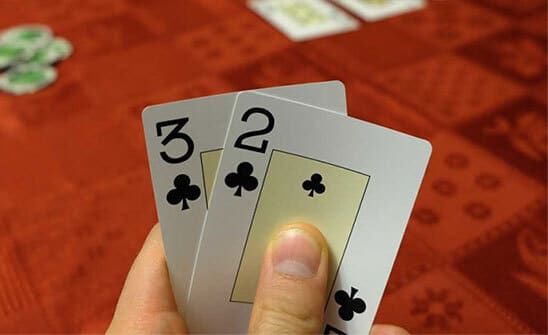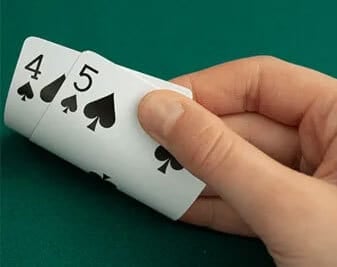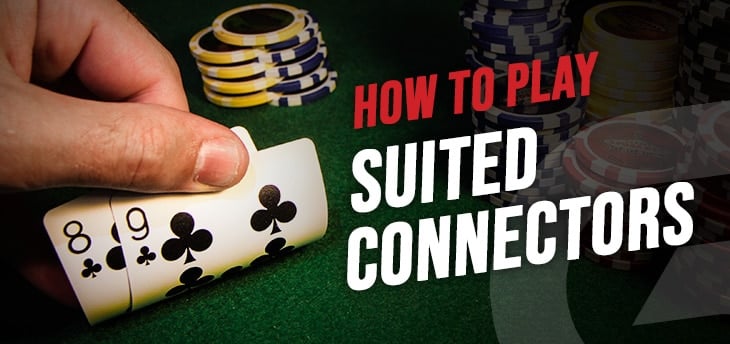Suited connectors are versatile hands favored by many great poker players such as Daniel Negreanu, who, in combination with his great hand-reading skills, uses them to outplay his opponents. In the hands of less experienced players, suited connectors can be troublesome hands – especially when played without the appropriate stack depth or when out of position. Knowing when (and when not) to get involved in a pot with suited connectors is a key factor in improving your overall strategy and profitability when playing poker.

Avoid Reverse Implied Odds Situations
Contrary to popular belief, middle and low suited connectors are not great hands in multiway pots. Poker solver tools, such as GTO Wizard, recommend folding suited connectors on the button after an initial raise and a couple callers, whereas it would have a player call (or re-raise) against a single raiser without callers. This is because suited connectors suffer from reverse implied odds – a pot odds calculation that considers how much we could potentially lose on a hand – particularly when stacks are very deep. As the number of players in a pot increases, the chances of getting ‘coolered’ – making a strong hand but running into an even stronger hand – increases with hands that don’t make the nuts. Imagine a scenario wherein a player raises from early position and gets three callers. You look down at 78 of diamonds and decide to call. The flop comes K34 with two diamonds, giving you a flush draw. The initial raiser bets and gets two callers. This is a precarious situation because it is likely one of the callers has a dominating flush draw. The two most likely outcomes in this scenario are you’ll make a flush and not get a lot of action, or you’ll make a flush and get a lot of action from the villain with a bigger flush. The same scenario can also occur when you make the “dummy end” of a straight, such as 78 on a 9TJ flop. In this spot, running into KQ (a higher straight) is a very real possibility when you get a lot of action.

Remain Unpredictable
One of the main benefits of playing suited connectors is that they give you board coverage – a measurement of how well your hand will interact with any flop, turn and river. By including suited connectors into your preflop raising and three-betting range, your opponents will never know with certainty whether they have the best hand based on the community cards. Against a predictable, tight player who raises from early position, it would be difficult for them to have a very strong hand on a flop of 4-5-6, for example, because they won’t have small pocket pairs or low suited connectors in their range. Perceptive players will be aware of this fact and use it to apply max pressure on their tight opponents – often forcing them to fold the best hand.
This does not mean suited connectors should always be raised, particularly from earlier positions. Raising from an early position can be dangerous as the likelihood of an opponent having a very strong hand increases. As a rule of thumb, open raise with suited connectors no more than one-third of the time from earlier positions and increase that amount as you get closer to the button. By doing this, you can remain unpredictable while also avoiding the pitfall of playing too many hands.
Suited connectors also make great three-betting hands when used sparingly for three main reasons. First, your opponent may fold preflop with what was almost certainly a better hand, allowing you to win a decent-sized pot uncontested. Second, suited connectors often flop some form of draw which would allow you to semi-bluff across multiple streets. Semi-bluffing both maximizes the chance your opponent will fold and builds a large pot for the times when your opponent doesn’t fold but you hit your draw. Finally, by three-betting suited connectors, you will remain unpredictable to your opponents because they won’t automatically be able to put you on a premium hand. A quick and easy way to randomize when you three-bet a suited connector is by looking at the second hand of a watch or clock. If it falls in a predetermined range, such as between the 12 and 3, you would three-bet otherwise you call or fold.

Pay Attention to Stack Sizes
Suited connectors tend to play best against a single opponent when stacks are sufficiently deep (around 75 big blind or more). Against short stacks, suited connectors lose value because they cannot win enough money when they make a strong hand and can’t be used as bluffs as effectively. Unlike small pairs, which will either flop a very strong hand or miss entirely, suited connectors often need several streets to realize their full potential. This can be in the form of a draw that needs enough money behind to get paid off when they hit on the turn or river, or in the form of a bluff that needs to threaten an opponent’s remaining stack on future streets. For example, say you open with 5-6 of hearts from a middle position and the big blind calls. The flop comes J47 rainbow, giving you an open-ended straight draw. Your opponent checks, you bet, and they call. The turn brings a king and your opponent checks again. This would typically be an excellent spot to continue bluffing as the king is better for your overall range; however, if your opponent started the hand with a short stack and they have already committed a sizable portion of it on the flop, they may feel “pot stuck” and begrudgingly call any bet with any pair or draw, which is bad for your just six-high hand. If your opponent started the hand with a deep stack, a large bet on the turn puts them into a difficult spot with most of their one-pair type hands as they must worry about the prospect of facing another large bet on the river.

Conclusion
Armed with this basic knowledge, you should be able to start improving your game when dealt suited connectors. Set out a plan and stick to it. While it may be a bit uncomfortable to start, with practice you will be playing those suited connectors like a pro.




